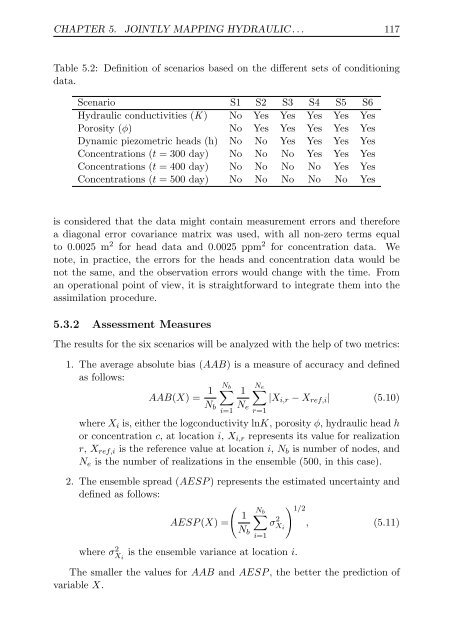Upscaling and Inverse Modeling of Groundwater Flow and Mass ...
Upscaling and Inverse Modeling of Groundwater Flow and Mass ...
Upscaling and Inverse Modeling of Groundwater Flow and Mass ...
You also want an ePaper? Increase the reach of your titles
YUMPU automatically turns print PDFs into web optimized ePapers that Google loves.
CHAPTER 5. JOINTLY MAPPING HYDRAULIC . . . 117<br />
Table 5.2: Definition <strong>of</strong> scenarios based on the different sets <strong>of</strong> conditioning<br />
data.<br />
Scenario S1 S2 S3 S4 S5 S6<br />
Hydraulic conductivities (K ) No Yes Yes Yes Yes Yes<br />
Porosity (ϕ) No Yes Yes Yes Yes Yes<br />
Dynamic piezometric heads (h) No No Yes Yes Yes Yes<br />
Concentrations (t = 300 day) No No No Yes Yes Yes<br />
Concentrations (t = 400 day) No No No No Yes Yes<br />
Concentrations (t = 500 day) No No No No No Yes<br />
is considered that the data might contain measurement errors <strong>and</strong> therefore<br />
a diagonal error covariance matrix was used, with all non-zero terms equal<br />
to 0.0025 m 2 for head data <strong>and</strong> 0.0025 ppm 2 for concentration data. We<br />
note, in practice, the errors for the heads <strong>and</strong> concentration data would be<br />
not the same, <strong>and</strong> the observation errors would change with the time. From<br />
an operational point <strong>of</strong> view, it is straightforward to integrate them into the<br />
assimilation procedure.<br />
5.3.2 Assessment Measures<br />
The results for the six scenarios will be analyzed with the help <strong>of</strong> two metrics:<br />
1. The average absolute bias (AAB) is a measure <strong>of</strong> accuracy <strong>and</strong> defined<br />
as follows:<br />
AAB(X) = 1<br />
Nb Ne ∑ 1 ∑<br />
|Xi,r − Xref,i| (5.10)<br />
Nb<br />
Ne<br />
i=1 r=1<br />
where Xi is, either the logconductivity lnK, porosity ϕ, hydraulic head h<br />
or concentration c, at location i, Xi,r represents its value for realization<br />
r, Xref,i is the reference value at location i, Nb is number <strong>of</strong> nodes, <strong>and</strong><br />
Ne is the number <strong>of</strong> realizations in the ensemble (500, in this case).<br />
2. The ensemble spread (AESP ) represents the estimated uncertainty <strong>and</strong><br />
defined as follows:<br />
(<br />
Nb<br />
1 ∑<br />
AESP (X) = σ 2 ) 1/2<br />
Xi , (5.11)<br />
where σ 2 Xi<br />
Nb<br />
i=1<br />
is the ensemble variance at location i.<br />
The smaller the values for AAB <strong>and</strong> AESP , the better the prediction <strong>of</strong><br />
variable X.


